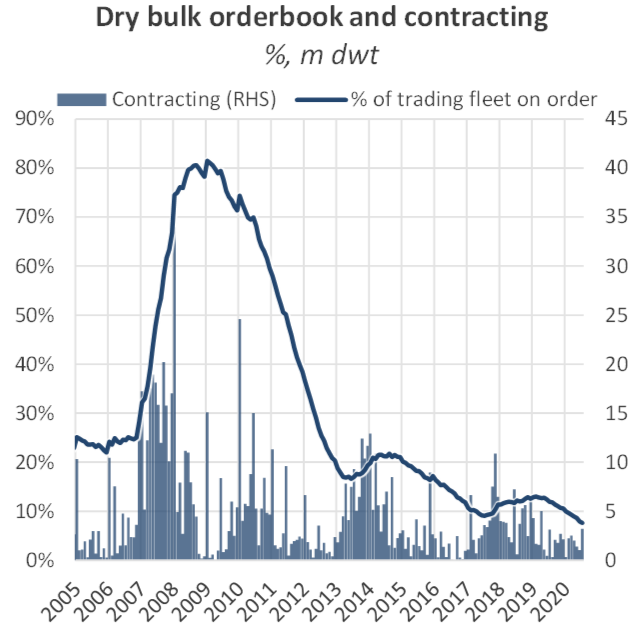By Nick Ristic
Low orderbooks
2020 has been a big year for supply growth so far. While the pandemic has generated some degree of slippage, certain sectors have seen heavy additions. The dry bulk fleet as a while has grown by almost 25m dwt, an increase of nearly 3% since the start of the year. In the Cape market, we’ve seen 9.6m dwt of Newcastlemax capacity come onto the water, though fleet growth for the Capesize sector as a whole has been kept somewhat at bay by removals of some of the old converted units earlier in the year.
Meanwhile in the Panamax sector, we’ve seen supply grow by almost 5% so far this year, with 125 vessels joining the fleet and just 7 ships removed. (see our Big Picture on Aug 20th for more on the low levels of Panamax scrapping). And within the Supramax market, we’ve seen heavy Ultramax additions add to oversupply in the market. Earlier this year the Ultramax fleet surpassed 1,000 ships, growing by almost 11% YTD.
We expect these deliveries to be felt in the market in the coming months, but further out we are faced with a very limited orderbook. In dwt terms, the current orderbook represents just 7% of the trading fleet, the lowest level since the late 80s.
This is a product of extremely low levels of contracting. 2020 is set to see the lowest volume of orders for new ships placed since 2016, and the second lowest since 2001 with just 138 vessels ordered to date.
Contracting by sector
Across the bulker segments, we see similar trends in the orderbook, though there are some key differences. The Capesizes have the largest orderbook expressed both in absolute dwt terms and as a percentage of today’s fleet. With almost 32m dwt slated to deliver over the early 2020s, the orderbook amounts to around 9% of today’s carrying capacity. But this is still the lowest fraction on order since 1997.
For the Panamaxes, we have just over 16m dwt on order, translating to around 7% of todays fleet, though a third of this figure is made up of ships which are scheduled to deliver later this year. In the Supra segment, there is 11.4m dwt of capacity on the books, representing under 6% of current capacity (the lowest since 1993).
The Handy fleet stands out as one sector which has both a very low forward orderbook and has seen limited additions so far this year. The 10-40k dwt sector has grown by just 1.2% in dwt terms so far this year, a net increase of 26 units. And going forward, the orderbook stands at 115 vessels, which add up to around 4% of today’s Handy capacity.
What has been ordered?
Of the limited number of vessels that have been contracted this year, a few features have stood out.
Capesize ordering has continued to focus heavily on the Newcastlemax design, including a greater number of LNG dual fueled ships. And ordering in the Panamax sector has continued to favour Kamsarmax and Post-Panamax sizes, with only 3 ‘standard’ Panamax designs ordered.
The Supramax sector has seen the greatest volume of orders so far this year, with 53 vessels contracted. Ultramaxes have seen sustained interest, but we’re also seeing elevated orders for smaller vessels within our broader Supramax category. We’ve seen 11 ships ordered in the 40-42k dwt band, a size which is proving increasingly popular given that many of these vessels have the same draft as a typical Large Handy, with a wider beam allowing for greater cargo intake.
Meanwhile, Handy ordering has been more skewed to the smaller sizes. So far this year we have recorded 16 ships ordered within the 10-25k dwt range. This is the greatest number of orders in this segment since 2014.
Period of restraint?
So with the orderbook this depressed, is another wave of ordering activity around the corner? This is what we saw in 2013 and 2017 when the percentage on the fleet on order was trending down in a similar fashion, but there are some key differences between those periods and the landscape we currently face.
Firstly, environmental scrutiny and uncertainty over regulation are at the forefront of investors’ minds. IMO 2030, IMO 2050 and more recent EU carbon emission rules pose serious questions over fuel choice and vessel design.
This is a key issue holding shipowners back when considering fleet renewal and, in the absence of clarity on the best way to comply with these regulations, we expect it to keep a lid on the orderbook. A relatively strong steel price has also kept newbuilding prices firm. For some investors, these prices seem out of step with freight market expectations, given high levels f oversupply in some sectors.
And of course the Covid-19 pandemic has added another layer of uncertainty to the picture, with volatility taking a step increase. Just in the last few months we have seen Capesize earnings hover at Opex levels, before setting the record for the greatest daily change in rates, and this has filtered through into the smaller sizes.
Going forward, we expect ordering activity to remain at these low levels, which should help to ease oversupply in the coming months. However there is always the risk of another ordering spree if newbuilding prices do ease significantly. Though we view this as unlikely, it does represent a downside risk to our utilisation outlook.




